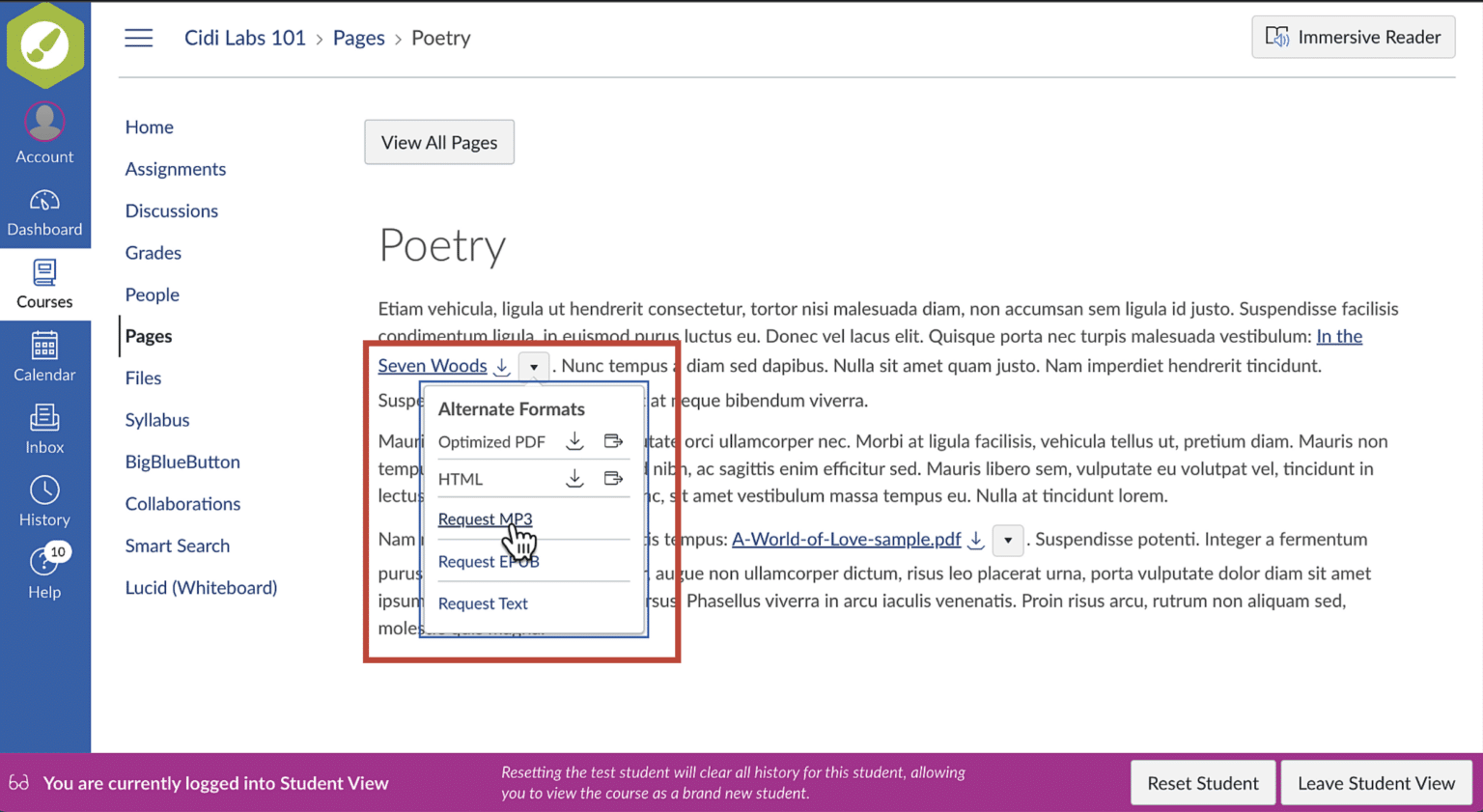UDOIT Provides Alternative Formats of Course Materials
For information on the faculty UDOIT interface in Canvas, visit the CETL UDOIT webpage.
Students can access alternative-format course documents on the fly in a course with UDOIT enabled. In the Canvas LMS student view, next to each file is a drop-down menu that will reveal an alternate format for the course document. Alternative formats benefit everyone. For example, maybe you have a lot of course material to read and get eye strain, or you're an auditory learner. Listen to an audio format of the learning materials by selecting Audio MP3 from the UDOIT drop-down.
Don't stick to just one format! Use as many formats as you want. For example, if it isn't in your first language, you could follow along in the ePub as you listen to the audio file, all from the comfort of your favorite coffee shop or study corner. Choose the format, or formats, that best suit your learning needs.
What alternative formats does UDOIT generate?
UDOIT provides alternative formats for the following file types:
- PDF's
- HTML
- MP3's
- EPUB
- Text files
Which Format Should I Use?
Not sure what format to download? Let us help you decide. This table shows at-a-glance the best formats for your different needs.
| Your needs | Alternative formats |
|---|---|
| Adjust text, font, and background color | |
| Adjust audio playback speed | ✓ (mp3 alt files) |
| Commuting | ✓ (audio / epub / html) |
| Commuting, driving | ✓ |
| Copy, paste, and search | ✓ (HTML page conversions) |
| Format adapts to device, responsive | ✓ (HTML/ePub) |
| Highlighting, note taking, bookmarking | |
| Mobile device | ✓ (HTML/ePub accessible on mobile) |
| Offline | ✓ (replace/upload accessible files) |
| Prefer listening | ✓ (audio formats) |
| Prefer reading | ✓ (ePub/HTML/text formats) |
| Text-to-speech with speed adjustment | ✓ (audio & HTML ePub) |
| Different language | ✓ (HTML/ePub translatable/downloadable) |
The Optimized PDF format refers to an automatically generated, accessible version of a PDF that improves readability and usability, especially for students with disabilities or those who prefer alternative formats.
It’s one of several alternative formats UDOIT offers, and it typically includes:
- Tagged structure for screen readers
- Selectable and searchable text
- Improved reading order
- Reduced file size (optimized for mobile and low-bandwidth environments)
- Accessible headings and lists
- OCR processing (if the original was scanned)
What is HTML? Tags and elements—such as blockquote, paragraph, and headings—are added to add meaning to a page. These tags and elements aid screen reader users with good content structure.
HTML is viewed in a browser and adapts to the device you are viewing it on.
Maybe these sound like you. If so, HTML is a good option.
- You want to adjust the font size and background color.
- You want to highlight content, take notes, and bookmark important pages.
- You want to be able to copy, paste, and search text.
- You want to use text-to-speech and adjust the speed of the speech.
- You prefer to read.
- You use a screen reader.
The audio alternative reads aloud the text in the original content. This also includes alternative descriptions for images, if they are provided.
The audio format is saved as an MP3. MP3s are compressed, high-quality sound files that can be played on any computer or mobile device.
Maybe these sound like you. If so, audio is a good option.
- You prefer to listen than read.
- You’re an auditory learner.
- You want to read and listen to the content at the same time.
- You have a lot of material to read and find your eyes get tired.
- You read on your commute.
- You don’t want to, or can’t, carry print materials for any length of time.
- You have a visual impairment.
- You want to adjust the speed of the audio.
The ePub alternative creates a digital publishing file that can be viewed on mobile devices. ePub files are reflowable. Reflowable means that the content displayed automatically adapts to the device it is viewed on.
Why use ePub?
ePub is powerful. With it, readers can take notes, highlight content, adjust text and background, and in some cases use text-to-speech.
Maybe these sound like you. If so, ePub is a good option.
- You want to adjust font size and background color.
- You want to highlight content, take notes, and bookmark important pages.
- You want to be able to copy, paste, and search text.
- You want to use text-to-speech and adjust the speed of the speech.
- You prefer to read.
- You read on your commute.
Here are a few suggested apps for ePubs.
- Apple: EasyReader, iBooks, Voice Dream, NaturalReader, and Thorium Reader
- Android: EasyReader, Lithium, and Voice Aloud Reader
- Windows: Calibre, Icecream Ebook Reader, NaturalReader, and Thorium Reader
- Linux: Thorium Reader
Text Format is a student-initiated tool in UDOIT that bridges gaps in accessibility when automation falls short. It ensures no student is left without access, even for difficult or unsupported file types.
It's one of the alternative format that the tool provides, and it typically is used when:
- No alternative formats are available
- The automatically generated formats (like optimized PDF, HTML, or audio) don’t meet their specific needs
- Providing students with a form or prompt to explain what format they need (e.g., large print, tagged PDF, plain text, etc.)
- Notifying instructors or accessibility staff (depending on how your institution configures it)
- Allowing for manual remediation or file preparation tailored to the student’s request


